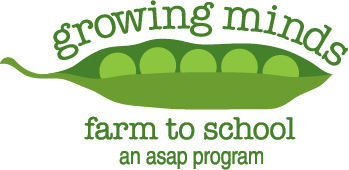This week’s theme is winter greens. Our “Growing Minds Day by Day” educational resource lists are designed for families and educators.
Growing Minds Day by Day
Winter Greens
Books:
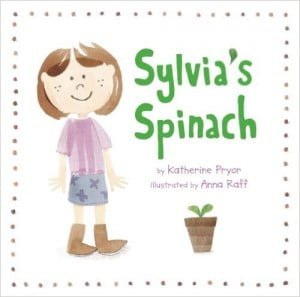 Sylvia’s Spinach
Sylvia’s Spinach
When her teacher passes out vegetable seed packets to each of her students, Sylvia gets stuck with spinach, her least favorite vegetable. While disappointed at first, through gardening she discovers the joy of growing food and the pleasure of smelling, licking, and then even tasting something new. Watch a read aloud with the author, Kathrine Pryor, on YouTube. Recommended for ages 4-8.
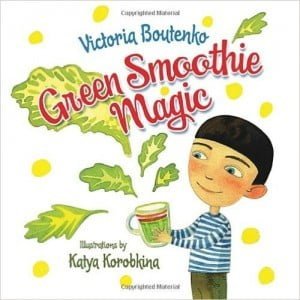 Green Smoothie Magic
Green Smoothie Magic
This story by author Victoria Butenko aims to get kids excited about nutrition, healthy foods, vegetables and fruits, green smoothies, and the science of plants. After learning about the amazing way that plants make their own food from sunlight, Nic goes home determined to eat more vegetables so he can grow big and strong. He’s quickly disheartened when he is put off by the bitter taste of lettuce. But his mother thinks of a way to ensure he can have a tasty, healthy diet. Buying a blender the next day, she whips up some raw-food green smoothie magic. Nic is hesitant at first, but his natural curiosity wins out, and he is soon asking for seconds. Recommended for ages 4-8.
Want to make a green smoothie for your kids to try? Start out by adding less greens and more fruit, then slowly introduce more greens over time. Baby spinach is sweeter than some other greens, making it a good choice to introduce first. Check out our recipe for a kid-approved green fruit smoothie.
Find more books
Visit the Growing Minds’ farm to school literature database to discover more of our favorite children’s books. Use the search bar to explore more of our favorite stories.
Local Food Recipe:
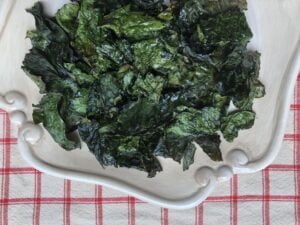 Kale chips are a kid-friendly way to introduce children to leafy green vegetables. They’re affordable and easy to make, and locally grown kale is available at farmers markets in our region throughout much of the year, including in the winter months.
Kale chips are a kid-friendly way to introduce children to leafy green vegetables. They’re affordable and easy to make, and locally grown kale is available at farmers markets in our region throughout much of the year, including in the winter months.
More importantly, kids can assist with just about every step of this simple recipe. In addition to building important developmental and life skills, getting kids involved in the kitchen will make them more enthusiastic about trying new foods. You can use our printable Kids Cooking Bingo card to track their culinary achievements.
Fun fact: As you and your children wash the leaves of kale leaves, you may notice that the water turns into round beads and quickly rolls off the leaves. That’s because the leaves of kale are hydrophobic, or water-hating. As such, consider submerging greens like kale and collards in a tub of cold water in order to loosen any soil or bugs that may be on the leaves.
Kale Chips
Serves 6
Ingredients:
- 1 bunch local kale
- 1 Tbsp. olive oil
- Salt
Directions:
- Preheat the oven to 350°F. Line a non-insulated baking sheet with parchment paper.
- Fold kale leaves along the stem and the tear stem away from the leaves. Tear leaves into bite-sized pieces.
- Place kale in a large bowl and drizzle it with olive oil and sprinkle with salt.
- Place the kale on the lined baking sheet and bake until the kale’s edges are brown but not burnt, about 10-15 minutes
Find more of our kid-friendly recipes for kale and other greens here.
Educational Resources:
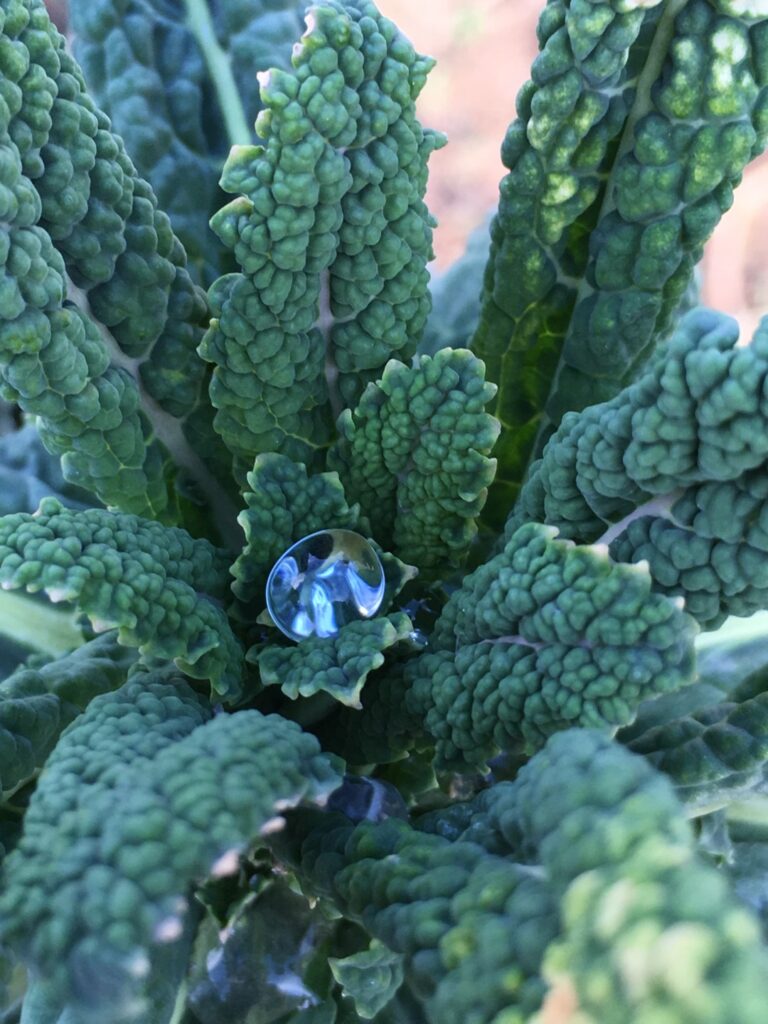
Fun Facts about Winter Greens
- In the Southern United States, greens are traditionally eaten on New Year’s Day for good luck. Greens resemble money and symbolize good fortune in the coming year. Favorites include collard greens, cabbage, kale, and mustard greens.
- Kale, collard greens, and cabbage are members of the same plant family, the brassica or cole family. Other members of the family include Brussel sprouts, bok choy, cauliflower, broccoli, turnips, and many more crops.
- Spinach is in the same plant family as beets, Swiss chard, and quinoa.
- Kale comes in dark green, blue-green, red, and purple colors.
- One variety of kale has bumpy green skin which lends it its common name, “dinosaur kale”. This variety is also known as Tuscan kale or lacinato kale.
- Cold-hearty winter greens taste best when harvested after a frost. The cold temperatures make the leaves taste sweeter and more flavorful.
- The leaves of kale and collard greens are hydrophobic, meaning they repel water. After it rains, look for little beads of water collected on their leaves in the garden.
- Dark leafy greens like kale, spinach, and collards are considered superfoods by nutritionists. They’re packed with vitamins A, C, and K, plus essential minerals.
Growing Minds Lesson Plans
- Cabbage Exploration (Preschool): Children gain confidence in trying new foods and become familiar with a new vegetable. Through a hands-on activity, children explore a new vegetable and taste two varieties of cabbage.
- Cooking Play (Preschool): Children learn about a variety of cooking tools including plastic knives, measuring spoons and cups, whisks and mixing spoons. Through a fun, dynamic learning environment children explore how to use the tools successfully.
- Vegetable Castles (Preschool): Children become comfortable with tasting new foods in the supportive, positive environment of their preschool. Children learn about and learn to identify different types of local fruits and vegetables.
- Cabbage Exploration (K-2): Introduce students to cabbage and guide them in closely observing characteristics of, and tasting, several cabbage varieties.
- Veggie Crowns (K-2): Introduce students to new fruits and vegetables.
- Stem Exploration (K-2): Teach students about the parts of plants and their functions and use the garden to teach a hands-on plant based activity.
- Eating in Season (3-5): Guide students in using scientific inquiry to design a seasonal taste test and investigate what produce is grown nearby seasonally, if locally grown foods tastes better, and what other factors might play a role in flavor. Groups will graph and summarize results and the class has the opportunity to discuss benefits of seasonal meal planning and eating locally grown products.
Activity:
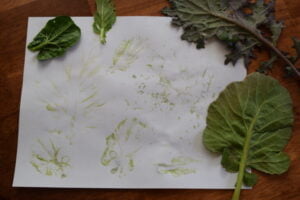 Chlorophyll Rubbings
Chlorophyll Rubbings
The leaves of winter greens like kale, collards, and spinach contain chlorophyll, the green pigment in plants that is used to capture energy from the sun. The process that plants use to turn this energy into food is called photosynthesis.
Children can transfer the green pigment of chlorophyll onto a piece of paper using a leaf rubbing technique. Place a leaf of spinach, lettuce or another leafy green between two sheets of white paper. Then, using the back of a metal spoon, rub the leaves vigorously over the paper. The chlorophyll in the leaf will be transferred to the paper. Note that it’s easier to transfer the pigment from delicate greens; tougher greens, like collards or kale, will require you to press harder on the paper. Educators can find a lesson plan for chlorophyll rubbings by the New Jersey Agriculture Society here.
Meet Your Farmer:
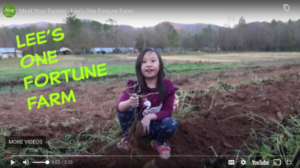 In our latest Meet Your Farmer video, spend an afternoon with local farmer Chue Lee and her daughter Ariel at Lee’s One Fortune Farm in McDowell County, North Carolina. The Lee’s grow many interesting crops on their family farm, including the purple sweet potatoes and bok choy (an Asian leafy green vegetable that is related to kale and collards) seen in this video. They also grow Asian pears and persimmons, bitter melon, several varieties of rice, and more. The Lee’s sell their produce at farmers tailgate markets throughout Asheville. Learn more about the history of this family farm and the rice they grow. This video could be used as the starting point to explore many topics with students, including soil, worms, sweet potatoes, nutrition/trying new vegetables, and farm life. Find related lesson plans, comprehension questions, extension activities, and a journal prompt at the video’s link.
In our latest Meet Your Farmer video, spend an afternoon with local farmer Chue Lee and her daughter Ariel at Lee’s One Fortune Farm in McDowell County, North Carolina. The Lee’s grow many interesting crops on their family farm, including the purple sweet potatoes and bok choy (an Asian leafy green vegetable that is related to kale and collards) seen in this video. They also grow Asian pears and persimmons, bitter melon, several varieties of rice, and more. The Lee’s sell their produce at farmers tailgate markets throughout Asheville. Learn more about the history of this family farm and the rice they grow. This video could be used as the starting point to explore many topics with students, including soil, worms, sweet potatoes, nutrition/trying new vegetables, and farm life. Find related lesson plans, comprehension questions, extension activities, and a journal prompt at the video’s link.
—
That’s it for this week. Check back next week for new resources. Click here to access Day by Day resources from past weeks. If you didn’t find what you’re looking for here, please visit our Lesson Plans page.
